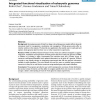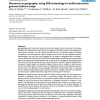BMCBI
2006
13 years 4 months ago
2006
Background: Increasing amounts of data from large scale whole genome analysis efforts demands convenient tools for manipulation, visualization and investigation. Whole genome plot...
BMCBI
2006
13 years 4 months ago
2006
Background: Genome databases contain diverse kinds of information, including gene annotations and nucleotide and amino acid sequences. It is not easy to integrate such information...
BMCBI
2006
13 years 4 months ago
2006
Background: Many commonly used genome browsers display sequence annotations and related attributes as horizontal data tracks that can be toggled on and off according to user prefe...
BMCBI
2006
13 years 4 months ago
2006
Background: We recently developed the Paired End diTag (PET) strategy for efficient characterization of mammalian transcriptomes and genomes. The paired end nature of short PET se...
BMCBI
2006
13 years 4 months ago
2006
Background: The identification of chromosomal homology will shed light on such mysteries of genome evolution as DNA duplication, rearrangement and loss. Several approaches have be...
BMCBI
2006
13 years 4 months ago
2006
Background: Genome sequences vary strongly in their repetitiveness and the causes for this are still debated. Here we propose a novel measure of genome repetitiveness, the index o...
BMCBI
2006
13 years 4 months ago
2006
Background: Whole genome sequence data is a step towards generating the 'parts list' of life to understand the underlying principles of Biocomplexity. Genome sequencing ...
BMCBI
2006
13 years 4 months ago
2006
Background: Many genome projects are left unfinished due to complex, repeated regions. Finishing is the most time consuming step in sequencing and current finishing tools are not ...
BMCBI
2006
13 years 4 months ago
2006
Background: The design of oligonucleotides and PCR primers for studying large genomes is complicated by the redundancy of sequences. The eukaryotic genomes are particularly diffic...
CANDC
2008
ACM
13 years 4 months ago
2008
ACM
Background: The Z-curve is a three dimensional representation of DNA sequences proposed over a decade ago and has been extensively applied to sequence segmentation, horizontal gen...


